The Art of Urban Gardening and Its Impact on Food Access
Urban gardening has been increasingly recognized for its positive impact on community development. When individuals from diverse backgrounds come together to cultivate urban green spaces, it fosters a sense of belonging and unity within the neighborhood. The act of gardening collectively not only beautifies the community but also encourages social interactions among residents, leading to stronger community ties.
Furthermore, urban gardening provides opportunities for skill-building and learning experiences. Through tending to plants, individuals develop a greater understanding of nature and food production processes. This hands-on approach to gardening not only promotes environmental awareness but also empowers community members to take control of their food sources and contribute to a more sustainable future.
Urban Gardening as a Sustainable Solution for Food Insecurity
Urban gardening offers a practical and sustainable solution to combat food insecurity in urban areas. By growing fresh fruits, vegetables, and herbs locally, communities can improve access to nutritious foods, reduce reliance on expensive store-bought produce, and increase self-sufficiency. This not only addresses immediate food needs but also promotes a healthier lifestyle among residents.
Additionally, urban gardening can empower individuals and communities to take control of their food sources and create a more resilient food system. By cultivating small plots of land, rooftops, or even vertical gardens, urban dwellers can contribute to local food production and distribution networks. This localized approach not only reduces the carbon footprint associated with food transportation but also fosters a sense of community pride and camaraderie as neighbors come together to grow and share the bounty of their harvest.
Innovative Techniques for Maximizing Small Urban Spaces for Gardening
City dwellers often face the challenge of limited space when it comes to gardening. However, with innovative techniques, even the smallest urban areas can be transformed into flourishing gardens. One effective method is vertical gardening, which involves utilizing vertical surfaces like walls or fences to grow plants. This technique not only maximizes space but also adds a visually appealing green element to urban landscapes.
Another technique for maximizing small urban spaces for gardening is container gardening. By using containers such as pots, buckets, or even repurposed items like old tires or wooden crates, urban gardeners can grow a variety of plants in a compact area. This method is versatile and allows for easy mobility, making it ideal for those with limited space or those living in rental properties.





